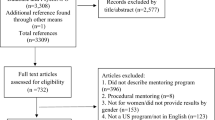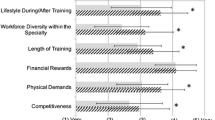ABSTRACT
BACKGROUND
The Department of Veterans Affairs (VA) instituted the VA Women’s Health Fellowship (VAWHF) Program in 1994, to accommodate the health needs of increasing numbers of female veterans and to develop academic leaders in women’s health. Despite the longevity of the program, it has never been formally evaluated.
OBJECTIVE
To describe the training environments of VAWHFs and career outcomes of female graduates.
DESIGN AND PARTICIPANTS
Cross-sectional web-based surveys of current program directors (2010–2011) and VAWHF graduates (1995–2011).
RESULTS
Responses were received from six of seven program directors (86 %) and 42 of 74 graduates (57 %). The mean age of graduates was 41.2 years, and mean time since graduation was 8.5 years. Of the graduates, 97 % were female, 74 % trained in internal medicine, and 64 % obtained an advanced degree. Those with an advanced degree were more likely than those without an advanced degree to pursue an academic career (82 % vs. 60 %; P < 0.01). Of the female graduates, 76 % practice clinical women’s health and spend up to 66 % of their time devoted to women’s health issues. Thirty percent have held a VA faculty position. Seventy–nine percent remain in academics, with 39 % in the tenure stream. Overall, 94 % had given national presentations, 88 % had received grant funding, 79 % had published in peer-reviewed journals, 64 % had developed or evaluated curricula, 51 % had received awards for teaching or research, and 49 % had held major leadership positions. At 11 or more years after graduation, 33 % of the female graduates in academics had been promoted to the rank of associate professor and 33 % to the rank of full professor.
CONCLUSIONS
The VAWHF Program has been successful in training academic leaders in women’s health. Finding ways to retain graduates in the VA system would ensure continued clinical, educational, and research success for the VA women veteran’s healthcare program.

Similar content being viewed by others
REFERENCES
"Report of the Under Secretary for Health Workgroup on Provision of Primary Care to Women Veterans." Women Veterans Health Strategic Health Care Group, Office of Public Health and Environmental Hazards; October 2008. Veterans Health Administration, Washington, DC.
Ferrer RL, Katerndahl DA. Predictors of short-term and long-term scholarly activity by academic faculty: a departmental case study. Fam Med. 2002;34:455–61.
Taylor JS, Friedman RH, Speckman JL, Ash AS, Moskowitz MA, Carr PL. Fellowship training and career outcomes for primary care physician-faculty. Acad Med. 2001;76:366–72.
Amrein K, Langmann A, Fahrleitner-Pammer A, Pieber TR, Zollner-Schwetz I. Women underrepresented on editorial boards of 60 major medical journals. Gend Med. 2011;8:378–87.
Reed DA, Enders F, Lindor R, McClees M, Lindor KD. Gender differences in academic productivity and leadership appointments of physicians throughout academic careers. Acad Med. 2011;86:43–7.
Morton MS, Sonnad SS. Women on professional society and journal editorial boards. J Natl Med Assoc. 2007;99:764–71.
Jagsi R, Motomura AR, Griffith KA, Rangarajan S, Ubel PA. Sex differences in attainment of independent funding by career development awardees. Ann Intern Med. 2009;151:804–11.
Jagsi R, Guancial EA, Worobey CC, et al. The "gender gap" in authorship of academic medical literature–a 35-year perspective. N Engl J Med. 2006;355:281–7.
Nonnemaker L. Women physicians in academic medicine: new insights from cohort studies. N Engl J Med. 2000;342:399–405.
Liu CQ AH. Promotion rates for first-time assistant and associate professors appointed from 1967 to 1997. Analysis in Brief, AAMC 2010;9.
Carnes M, Morrissey C, Geller SE. Women's health and women’s leadership in academic medicine: hitting the same glass ceiling? J Womens Health (Larchmt). 2008;17:1453–62.
Council on Graduate Medical Education Fifth Report. Women and Medicine. 1995. US Department of Health and Human Services PHSHRaSA.
Directory of Residency and Fellowship Programs in Women's Health. Association of Academic Women's Health Programs. J Womens Health (Larchmt). 2012;21:569–608.
Harris PA, Taylor R, Thielke R, Payne J, Gonzalez N, Conde JG. Research electronic data capture (REDCap)–a metadata-driven methodology and workflow process for providing translational research informatics support. J Biomed Inform. 2009;42:377–81.
Szilagyi PG, Haggerty RJ, Baldwin CD, et al. Tracking the careers of academic general pediatric fellowship program graduates: academic productivity and leadership roles. Acad Pediatr. 2011;11:216–23.
Anderson WA, Stritter FT, Mygdal WK, Arndt JE, Reid A. Outcomes of three part-time faculty development fellowship programs. Fam Med. 1997;29:204–8.
Leadley J SR. Women in US Academic Medicine: Statistics and Benchmarking Report 2009-2010. Association of American Medical Colleges.
Tesch BJ, Wood HM, Helwig AL, Nattinger AB. Promotion of women physicians in academic medicine. Glass ceiling or sticky floor? JAMA. 1995;273:1022–5.
Stamm M, Buddeberg-Fischer B. The impact of mentoring during postgraduate training on doctors' career success. Med Educ. 2011;45:488–96.
Levine RB, Mechaber HF, Bass EB, Wright SM. The impact of working part-time on measures of academic productivity among general internists. J Womens Health (Larchmt). 2010;19:1995–2000.
Levine RB, Lin F, Kern DE, Wright SM, Carrese J. Stories from early-career women physicians who have left academic medicine: a qualitative study at a single institution. Acad Med. 2011;86:752–8.
Guttman OR, Lingard L. Credentials as cultural capital: the pursuit of higher degrees among academic medical trainees. Acad Med. 2010;85:S21–4.
Simon SR, Shaneyfelt TM, Collins MM, Cook EF, Fletcher RH. Faculty training in general internal medicine: a survey of graduates from a research-intensive fellowship program. Acad Med. 1999;74:1253–5.
Borges NJ, Navarro AM, Grover AC. Women physicians: choosing a career in academic medicine. Acad Med. 2012;87:105–14.
Orlander JD, Callahan CM. Fellowship training in academic general internal medicine: a curriculum survey. J Gen Intern Med. 1991;6:460–5.
Splaine ME, Ogrinc G, Gilman SC, et al. The Department of Veterans Affairs National Quality Scholars Fellowship Program: experience from 10 years of training quality scholars. Acad Med. 2009;84:1741–8.
Yano EM, Hayes P, Wright S, et al. Integration of women veterans into VA quality improvement research efforts: what researchers need to know. J Gen Intern Med. 2010;25(Suppl 1):56–61.
Acknowledgements
Contributors
For their support in this project, we are grateful to members of the VHA Women Veterans Health Strategic Health Care Group and, in particular, to Dr. Laure Veet. Please note that the views expressed in this article are of the authors, and do not necessarily reflect the position or policy of the VA Healthcare System, Department of Defense or United States government.
Prior Presentations
These data were presented at the annual meeting of the Society of General Internal Medicine, May 2012, Orlando, Florida.
Conflict of Interest
The authors declare that they do not have a conflict of interest.
Author information
Authors and Affiliations
Corresponding author
Rights and permissions
About this article
Cite this article
Tilstra, S.A., Kraemer, K.L., Rubio, D.M. et al. Evaluation of VA Women’s Health Fellowships: Developing Leaders in Academic Women’s Health. J GEN INTERN MED 28, 901–907 (2013). https://doi.org/10.1007/s11606-012-2306-z
Published:
Issue Date:
DOI: https://doi.org/10.1007/s11606-012-2306-z




